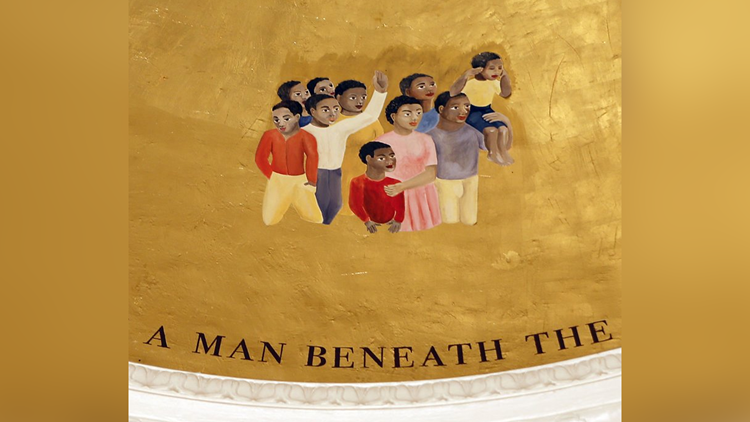LEXINGTON, Ky. (AP) — “There is not a man under the canopy of heaven, that does not know that slavery is wrong for him.”
This line, from Frederick Douglass’ 1852 speech “What to the Slave is the Fourth of July?” is now emblazoned around the domed ceiling of the University of Kentucky’s Memorial Hall entryway.
The words were carefully painted there this week by artist Karyn Olivier as she attempts to contextualize and commemorate one of UK’s most controversial spaces.
“I’m presenting what’s already there, but it’s remixed or reinterpreted,” Olivier said. “It makes sense to use what’s in front of me.”
What’s in front of her, and anyone who walks into Memorial Hall, is the 1934 lobby mural by Ann Rice O’Hanlon, depicting the history of Kentucky with a fresco that includes black workers, probably slaves, toiling in a tobacco field and a native American wielding a tomahawk. For more than a decade, the mural has provoked anger and hurt for students and others who find the images demeaning.
In 2015, a group of black students told President Eli Capilouto that the mural mirrored other problems with the campus’ racial climate, and UK joined many institutions and communities grappling with its memorialized past.
First, Capilouto ordered the mural to be covered. A year later, he uncovered it with historical context added below and appointed a task force to decide its future. That task force decided that art should beget more art that could put other perspectives in front of student eyes.
That perspective belongs to Olivier, a Trinidad-born and Philadelphia-based artist known for large works that play off public spaces, such as “The Battle is Joined,” a large, mirrored remix of an outdoor Revolutionary War Memorial.
Olivier, who was paid $30,000 for the UK commission, believes that O’Hanlon was both “progressive” and “subversive” in the way she chose to depict the different groups.
“It’s so clear she understood the role of slavery here,” Olivier said. “There are almost byzantine layers, but the slaves are front and center.”
To create her remix of O’Hanlon’s work, Olivier’s colleague Jay C. Lohmann first hand-applied more than 1,000 pieces of gold leaf to the dome to create the kind of sacred space often found in Byzantine churches.
Next, they painted larger copies of the black and native American figures, which will be set into the dome, above Douglass’ words. And in the four plain white medallions high up on the wall, there are now portraits of four figures from Kentucky history: Georgia Powers, the first black woman to serve in the Kentucky General Assembly; Charlotte Dupuy, a slave of Henry Clay, who sued him for her freedom in 1829; Chief Red Bird, a Cherokee chief who lived peacefully among the settlers of Clay County until he was murdered by two Tennessee men; and Peter Durrett, a slave who founded the First African Baptist Church, the third oldest congregation in the United States, which for many years was housed on Short Street.
Durrett and Dupuy were never photographed, so Olivier chose to represent them through black cut-paper silhouettes, a popular artistic method in the 19th century that itself has been most famously remixed by artist Kara Walker in her large scale silhouettes of racism and slavery in the U.S.
“What does it mean for people who were subjugated or caricatured to be moved into a sacred space?” Olivier asked. “The subjugated have been lifted to the divine as a rebirth.”
UK Art Musuem Director Stuart Horodner, who oversaw the commission, said that Olivier’s work has completely changed a drab entry way “into what’s now a room that needs to be engaged in,” he said. “It’s very challenging to take on a situation like this.”
Nicole Thorne Jenkins is an accounting professor who served on the mural task force, and stopped by Olivier’s installation Wednesday.
“I think it’s a good response,” she said. “It will invoke conversation that’s necessary on campus.”
Jenkins pointed out that the mural was one of many demands made by black students to improve culture on campus, including more diverse faculty and students.
“This was something concrete we can do,” she said. “Changing the culture of an institution is hard, long work, but I think responding to the mural is something that helps change the culture.”
As for Olivier, she won’t see the response to her work right away. A recently named Rome Prize winner by the American Academy in Rome, she will leave next week for a year in Italy. She hopes classes from all over the UK will come to see the work, ranging from art history to politics.
“I want the piece to be used, and discussed,” she said. “If that can happen once, I’ll feel like, ‘this is it.’”
___
Information from: Lexington Herald-Leader, http://www.kentucky.com



